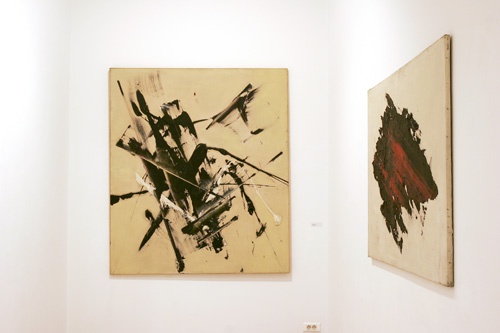-
1955-58 | Series "OUTBURST"
 Exhibition Judit Reigl, Galerie de France, Paris, 2006
Exhibition Judit Reigl, Galerie de France, Paris, 2006© Photo P.H.Müller
"The process of painting becomes...a physical and visceral activity. The paintings created by impulsive, spontaneous and random gestures of the body are ephemeral traces of the act of painting and of the artist’s body... The series Eclatement [Outburst], like explosive cards of the material touching the canvas, represents the confrontation between the surface and the body, the struggle that both constructs and destructs material and energy...The painting literally explodes in the pictorial field with a centrifugal motion, directing the gaze outside the frame, and the material thus exploding in every direction erases the surface hierarchy."
A. Berecz (catalogue to the exhibition Judit Reigl, années 50, Makláry Fine Arts, p.12) -
1957-59 | Series "Center of Dominance"
"On the face of the canvas, the centre presents itself as a maelstrom, abyss, vortex, delving into the depths of the work, moving and opening, forming and coming undone while constituting itself. Thus, it establishes a space in which the centre is everywhere and the periphery, nowhere."
Marcelin Pleynet, Reigl, Paris, Ed. Biro, 2001, p34 -
1956-66 | Series "Mass Writing"

Exhibition "Judit Reigl", Galerie de France, Paris 2006 © Photo P.H.Müller
"Painting is positioned through masses on a canvas. I bought a material normally used by masons – a ground black pigment that dries slowly, in depth, over the span of years, which meant that I was always working on six or eight paintings at a time. Starting from a white background, I put clumps of paint on the canvas using a flexible and rounded blade, or, sometimes, a simple wooden stick, “raising” them up from the bottom to the top of the canvas, covering the lighter colours underneath with this black pigment. I could tell immediately whether it was successful or a failure, in which case, there was no way of correcting it."
Unfolding: A Conversation Between Jean-Paul Ameline and Judit Reigl, Art in America international review, April 3rd, 2009 -
1964-66 | SÉRIE Weightlesness
« À partir de 1955, l’écriture automatique se lie sur de très grands formats en une écriture permanente sur fond blanc, écriture discontinue qui incorpore les accidents techniques (les dérapages de la main), utilise le vide (le blanc du fond) et les manques (les blancs du tracé). Ce travail produit quatre séries (Eclatements, 1955-58; Centres de dominance, 1958-1959; Ecriture en masse, 1959-65; Expérience d’apesanteur, 1965-66) où s’institue de l’une à l’autre un mouvement alternatif de regroupement et d’éclatement des centres, aboutissant à un premier renversement: noir autour/centre vidé: fond blanc en avant. »Jacques Schmitt, dans le catalogue de l’exposition Judit Reigl, Rétrospective, Rennes, Maison de la Culture, 1974















